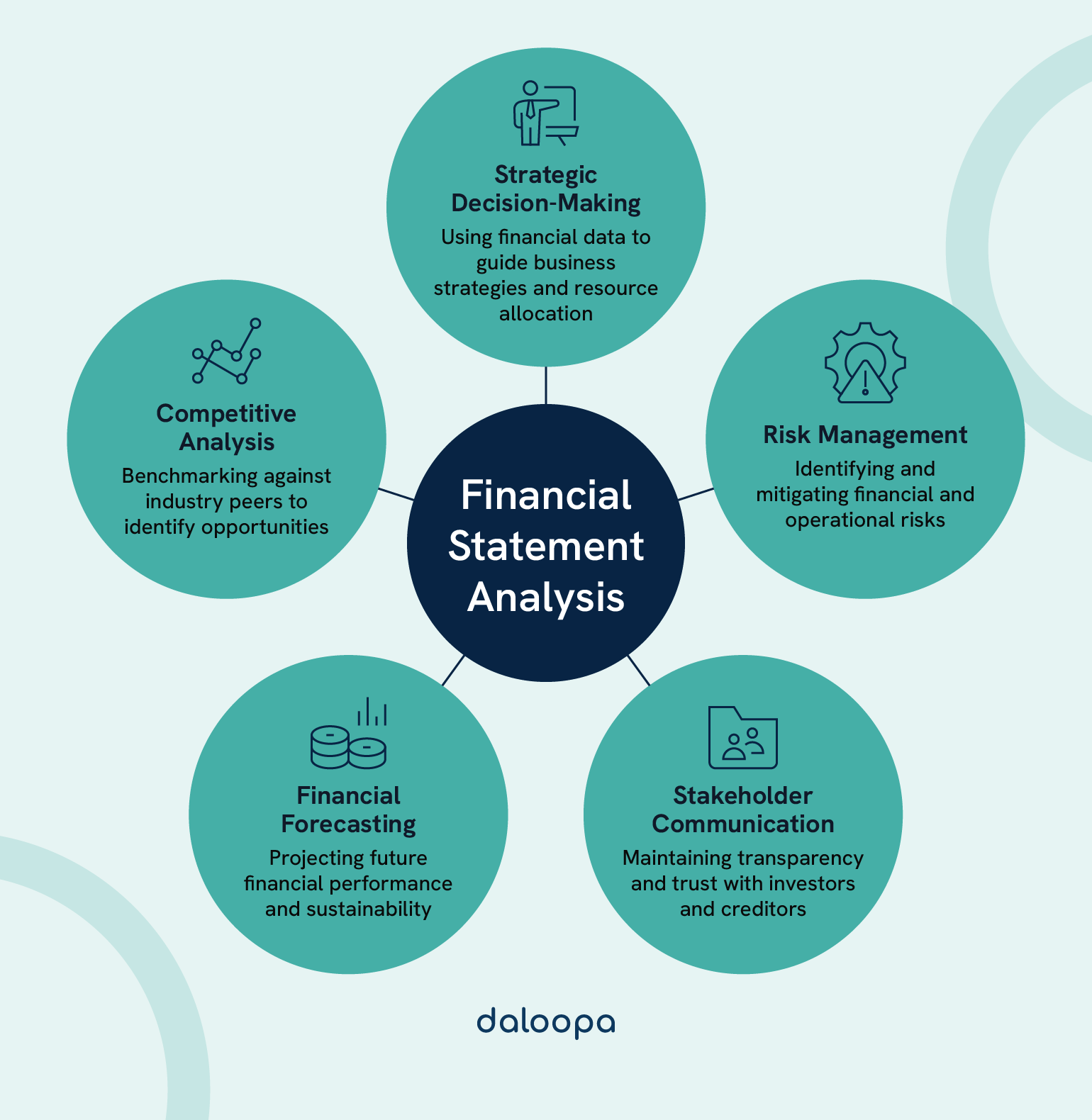You’re reviewing the latest financials, and something is off. Revenue isn’t growing as expected. Expenses are creeping up. There’s pressure to act, but no one agrees on the cause, let alone the solution.
This is where financial statement analysis proves its value. By digging into income statements, balance sheets, and cash flow reports, business leaders get a clear picture of where the company stands. The uses of financial statement analysis go beyond compliance—they guide decisions that shape future outcomes. It helps identify what’s driving performance, where inefficiencies lie, and whether the business is on stable ground or heading for trouble. Done right, financial analysis transforms raw data into decision-ready insights. It reveals patterns, exposes risk, and helps shape confident, strategic moves, not guesses.

1. Strategic Decision-Making
Analysis of financial statements delivers the factual clarity leaders need to make deliberate choices that support sustainable performance. Insights from historical data inform operational reviews, capital distribution, and competitive positioning. When paired with a powerful financial statement analysis tool, leaders gain timely insights that aren’t just informative—they’re transformative.
Performance Evaluation and Management
Ratios provide a sharp view of how teams, departments, and operations are performing. Using profitability measures like ROE, ROA, and margins, businesses can assess which areas are contributing most or least to overall success. This allows leaders to reallocate effort and spending toward initiatives that actually move the needle.
Not all progress is equal. Some numbers show growth, others show growing risk. These indicators separate the two:
- Efficiency Ratios: Help evaluate how effectively a company uses its assets and manages inventory. Wasted inventory or slow turnover often point to cash flow trouble ahead.
- Profitability Metrics: Highlight how pricing and cost controls contribute to financial outcomes and show whether current margins can withstand competitive or inflationary pressure.
- DuPont Analysis: Breaks ROE into detailed drivers for a clearer view of what’s behind earnings so leadership doesn’t chase top-line growth at the expense of sustainable returns.
Using vertical analysis, compare each cost item to total revenue. This reveals spending habits and supports fine-tuning strategies to control expenses without compromising growth. If operating costs creep up unnoticed, it can quietly erode profit even when revenue rises.
Resource Allocation and Capital Budgeting
Detailed financial insight enables leaders to direct limited resources toward the highest-value opportunities. Missed signals here can lock up resources in dead-end projects while better opportunities pass by.
Evaluate investment options using:
- Net Present Value (NPV)
- Internal Rate of Return (IRR)
- Payback Period
- Return on Invested Capital (ROIC)
Balance sheet analysis further supports decision-making by clarifying liquidity needs and financing options. Cash reserves that look healthy at a glance may not hold up under closer scrutiny, especially when liabilities come due.
Metrics tied to current assets support management of inventory and receivables. Debt and equity levels are weighed using leverage ratios to make prudent capital structure decisions.
Business Strategy Development
Carefully analyzed financial data reveals where companies hold an edge or where improvement is needed. These numbers are often the earliest signs that a strategy is stalling or working.
Comparative ratios like gross profit margins and operating efficiency show whether the company is leading, lagging, or just treading water.
Revenue growth patterns point to where the market is leaning and where efforts should intensify or shift. Efficiency ratios indicate whether operations can support that demand without adding unnecessary cost or whether scalability is hitting a ceiling.
From these metrics, businesses develop strategies to improve market share or move into new spaces. Working capital trends can influence whether expansion should come from organic growth or acquisitions.
Multi-year ratio analysis helps connect past strategic bets with present outcomes, guiding refinements to future plans. It separates smart risk-taking from costly overreach—another critical use of financial statement analysis for growth-focused firms..
2. Risk Assessment and Management
Thorough financial review helps organizations identify and address both short- and long-term risks. Among the essential uses of financial statement analysis is the early detection of financial threats before they spiral. Ignore these signals, and what looks like a temporary dip can quickly snowball into a crisis. This process supports asset protection, financial durability, and more confident planning.
Credit Risk Evaluation
Assessing a company’s ability to repay debt starts with leverage metrics. The debt-to-equity ratio reveals whether the firm is relying heavily on borrowed capital. Lower ratios typically mean stronger financial footing. A skewed ratio can trigger higher borrowing costs or limit future access to capital.
Fixed charge coverage shows whether recurring cash inflows are enough to meet ongoing obligations. A ratio above 2.0 usually reflects strong debt management. Fall below that, and lenders may start tightening terms or walking away.
Debt service coverage ratio (DSCR) compares net operating income to total debt service. A value above 1.25 is generally seen as a healthy threshold across many industries. If it drops too low, your business risks breaching loan covenants or defaulting under stress.
Liquidity Risk Management
The current ratio compares current assets to liabilities to show how well short-term obligations can be covered. A result over 2.0 often points to solid financial footing. If this slips, it may signal the early stages of a cash crunch.
Quick ratio strips out inventory from assets to give a clearer picture of funds readily available to meet urgent needs. This matters when vendors need payment and cash is locked in unsold stock.
Cash coverage ratio zooms in on actual cash and equivalents to provide the most conservative view of liquidity. This metric is the last line of defense when all other buffers are under pressure.
By tracking all three over time, often referred to collectively as a liquidity index, businesses can spot deteriorating or improving trends in cash access. Sudden shifts in this index often precede layoffs, loan requests, or emergency financing. This is a practical example of how financial statements comparison tools add clarity to risk analysis.
Operational and Financial Risk Identification
Shifts in asset turnover and margin trends often reveal whether operations are slipping into inefficiency or adapting well to new pressure. If these metrics dip without explanation, it could signal bloated overheads, pricing missteps, or operational drag that erodes profit from within.
Working capital indicators help uncover risks in daily operations. Monitoring how long inventory sits, how quickly receivables are collected, and how payables are scheduled helps anticipate short-term disruptions. Delays in collections or rising inventory backlogs can choke cash flow just when agility is needed most.
Also assess exposure to business cycle changes by reviewing fixed costs. The higher the fixed-cost base, the more vulnerable a firm is to drop in revenue. In a downturn, this can turn a manageable slowdown into a full-blown solvency threat.
Solvency ratios, including interest coverage, provide a long-view on whether the company can maintain financial commitments over economic swings. These metrics reveal if a business has the staying power to weather volatility or if it’s skating too close to the edge.
3. Stakeholder Communication and Relationship Management
Sharing financial insights clearly and consistently strengthens trust with key audiences. When numbers are vague or inconsistent, stakeholders fill in the blanks; and usually not in your favor. From shareholders to lenders, transparency builds credibility and helps manage expectations.
Investor Relations and Shareholder Communication
When it comes to investor relations, clarity counts. Regular analysis of performance metrics ensures investors stay informed and aligned with the company’s direction. Vague reporting or missed benchmarks can trigger doubt, sell-offs, leadership shake-ups, or even corporate collapse as in the Lehman Brothers’ ‘Repo 105’ case.
Reports commonly feature breakdowns of:
- Return on investment trends
- Earnings per share
- Dividend distributions
- Stock performance benchmarks
Using graphs and visuals to explain the data helps keep investors engaged and confident. Investors don’t just want data, they want direction. Presentations timed with earnings or milestone updates reinforce transparency and strengthen relationships. It also helps control the narrative before speculation sets in.
Lender and Creditor Relationship Management
Lenders depend on up-to-date financial insights to assess risk and monitor loan terms. Financial statements that emphasize repayment strength and risk management keep doors open when new funding is needed or terms need renegotiating.
Lenders look closely at:
- Debt service coverage
- Liquidity indicators
- Net working capital
- Cash flow strength
Routine reporting and open communication support better lender partnerships. Fall behind here, and you risk stricter terms, reduced credit lines, or outright denials. Sticking to financial covenants builds trust and ensures access to favorable credit terms. It also helps avoid technical defaults that could jeopardize operations.
Regulatory Compliance and Reporting
Financial statement analysis underpins compliance with accounting rules and public reporting obligations. Regulators don’t just check the boxes, they look for consistency, accuracy, and integrity. Follow GAAP or IFRS based on jurisdiction to ensure accuracy and consistency.
Regular filings include:
- Interim and annual statements
- Required disclosures
- Compliance certifications
- Supporting documentation for audits
Late, incomplete, or inconsistent filings can trigger penalties, audits, or restrictions that stall business activity. Strong internal systems support dependable data and reduce the risk of regulatory issues.
Openness in these reports reinforces reputation and improves alignment with regulatory expectations. It signals that the company is stable, well-governed, and capable of long-term compliance—qualities every serious stakeholder watches for.
4. Financial Planning and Forecasting
Robust financial analysis lays the groundwork for better future planning. One of the clearest uses of financial statement analysis is in creating budgets that align with market reality, not optimistic guesses. Companies use it to shape budgets, estimate outcomes, and avoid surprises. Without it, budgeting becomes guesswork, and surprises turn into setbacks.
Budgeting and Financial Projections
Forecasts start with pro forma statements that extend historical trends into future expectations. Look closely at past patterns in costs, margins, and income growth to set realistic financial goals. Miss those patterns, and you’ll chase targets with the wrong numbers.
We use data-driven models to project earnings, costs, and profitability, creating a roadmap for the year ahead. This roadmap becomes the basis for hiring, investment, pricing, cost control, and pretty much every core business lever.
Vital data points include:
- Expected revenue growth
- Operating margin assumptions
- Adjusted cost baselines
- Anticipated working capital needs
Flawed assumptions in any of these can leave your team underfunded or overcommitted before Q2 even hits.
Cash Flow Management and Planning
Cash flow statements break activity into core functions: operating, investing, and financing. Each one provides a snapshot of financial behavior and informs liquidity planning. These statements are the early warning system for financial strain.
We recommend a rolling 13-week cash flow model to catch imbalances before they become serious issues. Here, a digital financial statement analysis tool can provide real-time visibility that manual systems simply can’t deliver. This short-term lens gives decision-makers a fighting chance to correct course fast.
Daily and weekly monitoring keeps you in tune with:
- Payment terms
- Receivables timing
- Inventory turns
- Cash needs tied to seasonal cycles
Long-Term Financial Sustainability
Building long-term sustainability means understanding what funding the business will need and how to get it without compromising control or agility. By reviewing historical ratios, companies set realistic long-run targets. These targets guide not just growth plans, but survival plans.
Capital structure affects resilience. The mix of debt and equity depends on business goals, tolerance for risk, and the cost of funding. Over-leveraging can magnify gains in boom years, but it’s a fast track to disaster when the tide turns.
Big-picture planning also includes:
- Evaluating ROI on investments
- Prioritizing strategic alignment
- Measuring time to recoup capital
- Matching opportunities with internal capacity
These aren’t just theoretical checkpoints. They’re the difference between seizing growth and overreaching into chaos—proving once again the real-world uses of financial statement analysis in financial forecasting.
5. Competitive and Industry Analysis
Financial analysis doesn’t stop with internal data. Comparing company metrics to competitors helps identify where an organization leads or lags, and where new opportunities lie. Fail to benchmark correctly, and you risk falling behind while thinking you’re ahead. Many professionals use financial statements comparison tools to avoid this blind spot.
Benchmarking and Competitive Positioning
Side-by-side comparisons reveal whether you’re outperforming or quietly losing ground. Metrics like return on assets, gross margins, and liquidity ratios highlight relative strengths and vulnerabilities. Financial statements comparison tools make this process faster and more accurate, allowing businesses to automate side-by-side reviews across competitors and time periods.
Benchmarking priorities include:
- Revenue pace relative to industry
- Asset use and cost control
- Capital structure resilience
- Changes in market share
When a competitor gains ground, these numbers tell you where and why. Armed with hard comparisons, leaders can redirect capital, rethink priorities, or double down before market momentum shifts.
Industry Trend Analysis and Forecasting
If you’re not tracking the pulse of the industry, you may be building a plan for a market that no longer exists. By tracking trends in sales, margins, and investment, we gauge where the market is headed.
Core trend signals include:
- Shifts in revenue growth
- Margin compression or recovery
- Investment spending patterns
- Changes in working capital cycles
Spotting these signals early means adjusting before the rest of the pack or avoiding moves that no longer make sense. This knowledge helps align internal strategies with market movement and identify when a pivot might be needed.
Market Opportunity Assessment
Competitor financials are roadmaps to their blind spots. Used correctly, a financial statement analysis tool can mine competitor reports and uncover new opportunities. Assess where others are strong or weak by looking at how they allocate costs, generate revenue, and structure their operations.
Signals of opportunity:
- Segments with high margins
- Underserved customers or geographies
- Inefficiencies in peer operations
- New patterns in buying behavior
These insights may offer the opportunity to grab market share while others are still adjusting. They shape plans for expansion, product development, or deeper customer engagement, based on where data shows the most promise. Move fast here, and you’re not just keeping up. You’re setting the pace.
Turn Analysis Into Advantage
Financial statement analysis isn’t just a reporting task. It’s a core part of how businesses manage risk, plan ahead, and make better decisions. From budgeting and forecasting to investor updates and risk checks, it keeps leaders grounded in facts instead of assumptions.
But here’s the reality: doing it all manually slows you down and increases the chances of missed details. Daloopa simplifies the process and saves you hours of manual work. With Daloopa’s AI-powered solutions, you can automatically get financial statement data into Excel and always have everything organized and up to date for analysis. Choose a plan today and make your financial analysis faster, cleaner, and more reliable.



